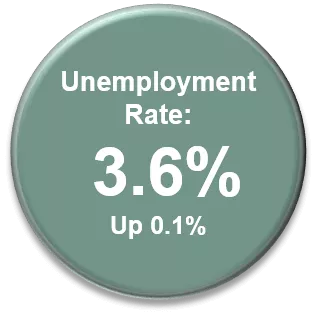February Economic Commentary: Moving Ahead at a Steady Rate

Chief Economist
Pohlad Companies
Recently released economic reports suggest that the economy continues to move ahead at a steady but unspectacular rate. We also received further confirmation that the consumer (the primary support for economic growth) was slowing spending as we moved through 2019. The impact of the coronavirus has not been reflected in any economic data yet, but it will assuredly have an impact on 1Q-20 numbers, which were expected to be relatively weak even before the virus erupted.
GDP
The initial estimate of 4Q-19 real GDP showed the economy advancing at a 2.1% annualized growth rate – the same as 3Q-19. For the full year of 2019, real GDP grew at 2.3%, down from 2.9% in 2018. While the headline number in 4Q-19 was slightly above expectations, the bigger surprise was that consumer spending rose only 1.8% in 4Q-19 compared to 3.2% in 3Q-19 and 4.6% in 2Q-19. Consumer spending was impacted by slower income growth and a renewed willingness to save as the year progressed.
Besides the disappointing consumer spending, business investment fell for the third consecutive quarter. The only part of business investment that has exhibited consistent strength has been spending on intellectual property products. Providing some strength during 4Q-19 was residential investment as the low mortgage rates lifted home sales and construction for the second quarter in a row.
Final sales to domestic purchasers, a good indicator of consumer demand, rose slightly at a 1.6% annualized rate, down from 2.2% in 3Q-19 and 3.6% in 2Q-19, indicating softening in demand.
1Q-2020 is expected to continue the trend of a slowing economy. Some pickup in exports is expected due to the Phase I China agreement, but the halt of the Boeing 737 Max production and the impact of the coronavirus will likely offset any gain in exports.

Employment
The January employment report indicated that the labor market remains healthy with nonfarm payrolls growing by 225,000, well above the pre-report estimate of 165,000. The household survey saw a net loss of 89,000 jobs and when combined with the 50,000 increase in the labor force, resulted in the unemployment rate ticking up to 3.6%, just off its 50-year low of 3.5%.
Wages advanced enough to cause the year-over-year pace to advance at 3.1% from a revised 3.0% in December.
Fed Rates
At the recently concluded meeting of the Federal Open Market Committee (FOMC), Chairman Powell stated that the Fed will try to keep rates steady throughout the year unless there is a ”material change” in the economic outlook to avoid any appearance of political interference in an election year. He did acknowledge, however, that the coronavirus has the potential to negatively impact global economic growth as the impact is already being felt in the travel and tourism industries.
Another impact of the coronavirus has been a renewed flight to quality in investment markets. Investors have sought protection by purchasing Treasury securities, resulting in the trade-weighted U.S. dollar strengthening 2.5% and the yield on 10-year Treasury Notes falling to nearly 1.50% after starting the year at 1.90%. If continued, the decline in longer-term yields will result in inversion of the yield curve, which may push the Fed into lowering the Fed Funds rate. It is too early to tell, but this bears watching.
In summary, the themes of a slowing (but not contracting) economy, developing caution by consumers, and low inflation have not changed. Continued monitoring of the health of the labor markets is warranted as a proxy for the health of the consumer, who is the primary support for economic growth.
Insights
Research to help you make knowledgeable investment decisions